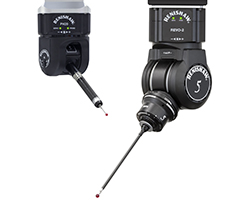5-axis technology
A measurement revolution
Unlike conventional CMM measurement methods, Renishaw's 5-axis technology uses synchronised motion of CMM and head axes to minimise the machine's dynamic errors at ultra-high measuring speeds.
What is 5-axis measurement?
Based on advanced head, sensor and control technology, Renishaw's 5-axis measurement technology delivers unprecedented measuring speed and flexibility, whilst avoiding the speed versus accuracy compromises inherent to conventional techniques. It boosts measurement throughput, minimises lead times and gives manufacturers a more comprehensive appreciation of the quality of their products.
Unlike systems based around indexing heads or fixed probes, 5-axis motion enables the stylus to follow a continuous path around complex components without having to leave the surface to change stylus cluster or index the head. Controller algorithms that synchronise CMM and head motion produce an optimal tip path and minimise CMM dynamic errors.

5-axis measurement technology explained
In conventional measurement methods the CMM performs all the movements necessary to acquire the surface data. Acceleration induces inertial deflections in the machine structure, which in turn induce measurement errors.
Metrology system manufacturers have devoted years to develop techniques that reduce those dynamic errors, but there is an upper speed limit imposed by the machine and servo system stiffness, beyond which measurement cannot be taken with reliability.
5-axis measurement technology breaks through that limit by using an articulating head that moves in two rotary axes as it measures. This allows the CMM to do what it is best designed to do - move at constant velocity in a single vector while measuring. As the head is much lighter and more dynamic than the CMM, with a significantly better bandwidth, it is able to quickly follow changes in the part geometry without introducing harmful dynamic errors, which results in much faster surface speeds and hence shorter measurement cycles.